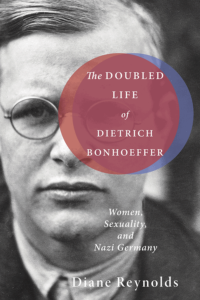The Doubled Life of Dietrich Bonhoeffer: Women, Sexuality, and Nazi Germany
Reviewed by Beth Taylor
October 1, 2016
 By Diane Reynolds. Cascade Books, 2016. 449 pages. $53/paperback; $9.99/eBook.
By Diane Reynolds. Cascade Books, 2016. 449 pages. $53/paperback; $9.99/eBook.
Buy from QuakerBooks
Dietrich Bonhoeffer (1906–1945) was a German Lutheran pastor, theologian, and anti-Nazi activist. He believed that “the personal was always theological and that the theological was always personal.” His theological writings, encouraging a “religionless Christianity”—Christ-centered activism outside a church—were embraced by liberal denominations like Quakers and influenced later leaders like Martin Luther King Jr.
Besides his theological writings, Bonhoeffer was known for his double life: working for the Abwehr, a German military intelligence organization, but vocally opposing Hitler’s agenda. He was arrested in April 1943 by the Gestapo and imprisoned for a year and a half. After being linked to a plot to assassinate Hitler, he was tried along with other former members of the Abwehr, and then executed by hanging in April 1945 as the Nazi regime was crumbling. Bonhoeffer’s execution lifted his life to martyrdom and mythology, despite his resistance to “pillar sainthood” when he was alive.
Bonhoeffer’s biography has been narrated before, including a book by his close friend Eberhard Bethge. Like most biographies covering his generation, his story in previous books followed “the great man” narrative, with the women in his life barely mentioned. Now, in The Doubled Life of Dietrich Bonhoeffer: Women, Sexuality, and Nazi Germany, Diane Reynolds reminds us that, like all biographies of great men, there were usually some interesting women involved with their stories. Indeed, Bonhoeffer’s grandmother, mother, twin sister Sabine, first love Elisabeth Zinn, fiancée Maria von Wedermeyer, and benefactor Ruth von Kleist Retzow each helped shape his life.
Reynolds is an award-winning journalist, so her writing is concise and clear. She brings alive the story of Bonhoeffer again, but with particular focus on his inner circle—intense relationships with his family, sister, fiancée, and friends. In the process, Reynolds illuminates the ways of influence, showing how Bonhoeffer’s views were shaped, including through the forces of sexuality—or its suppression, which complicated each relationship but intensified its impact on him.
The letters, memoirs, and journals of the women in his life reveal different aspects of not only his life, but also German life as it was changed forever by Hitler. Sabine, her brother’s twin and earliest confidante, is a talented woman—“artistic, musical, nurturing, and witty.” Bonhoeffer’s mentor Ruth was older, “a muse, kindred spirit, and comfort . . . whose home, where he so often ended up, soothed his soul.” Her granddaughter, Maria, became his fiancée and confidante in his final years, offering him a “deeply sardonic outlook” that grounded him, as well as an intimacy that was sanctioned.
The Bonhoeffers were a close-knit, well-off family “used to being in charge, sure of their privilege, and completely unintimidated.” But they also went hungry during WWI, and like other Germans, lived through bombings, raids, and, eventually, concentration camps. Nazi harassment startled them as early as 1928, when Sabine’s father-in-law was accosted for being a Jew, spurring Sabine to place her child, blonde-haired and blue-eyed, on the grandfather’s lap, deflecting the harassment. Dietrich, having finished his doctorate in theology, was off to the States, where, at Union Theological Seminary, he would become a pacifist and, despite his wealth, a convinced socialist.
Upon his return to Berlin in 1931, it was clear that Germany was changed forever. As Hitler tried to redefine Christianity into Aryanism, Bonhoeffer rallied ecumenical opposition. In 1933, two days after Hitler was installed as Chancellor, Bonhoeffer delivered a radio address attacking Hitler and warning Germany against slipping into an idolatrous cult. In 1934 he helped found the Confessing Church, insisting that Christ, not the Führer, was the head of the church. But by 1936 he was denounced as “a pacifist and enemy of the state” and barred from teaching theology at the University of Berlin.
Ruth von Kleist-Retzow funded Bonhoeffer’s efforts to create a seminary, where his students and their families could take refuge. After he was banned from Berlin in 1938, he moved his seminary from village to village and began his involvement with the German resistance. Under cover of the Abwehr, Bonhoeffer acted as a courier for the resistance movement to the allies and aided operations to help German Jews escape to Switzerland, including his sister Sabine and her family. Imprisoned, he kept writing, asserting his belief in “the principle of our Universal brotherhood which rises above all national hatreds.” But his long involvement with attempts to overthrow Hitler was exposed and led to his execution.
Through Reynolds’s masterful research, we experience Bonhoeffer’s daily life through his own words and through the eyes and thoughts of the women and men who loved him, argued with him, warned him, and supported him through Germany’s darkest decades. It is a vivid portrait of the private man behind the public “pillar saint.”



Comments on Friendsjournal.org may be used in the Forum of the print magazine and may be edited for length and clarity.